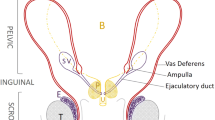Abstract
Congenital absence of the vas deferens (CAVD) is a frequent cause for obstructive azoospermia and accounts for 1%–2% of male infertility. A high incidence of mutations of the cystic fibrosis transmembrane conductance regulator (CFTR) gene has recently been reported in males with CAVD. We have investigated a cohort of 106 German patients with congenital bilateral or unilateral absence of the vas deferens for mutations in the coding region, flanking intron regions and promotor sequences of the CFTR gene. Of the CAVD patients, 75% carried CFTR mutations or disease-associated CFTR variants, such as the “5T” allele, on both chromosomes. The distribution of mutation genotypes clearly differed from that observed in cystic fibrosis. None of the CAVD patients was homozygous for ΔF508 and none was compound heterozygous for ΔF508 and a nonsense or frameshift mutation. Instead, homozygosity was found for a few mild missense or splicing mutations, and the majority of CAVD mutations were missense substitutions. Twenty-one German CAVD patients were compound heterozygous for ΔF508 and R117H, which was the most frequent CAVD genotype in our study group. Haplotype analysis indicated a common origin for R117H in our population, whereas another frequent CAVD mutation, viz. the “5T allele” was a recurrent mutation on different intragenic haplotypes and multiple ethnic backgrounds. We identified a total of 46 different mutations and variants, of which 15 mutations have not previously been reported. Thirteen novel missense mutations and one unique amino-acid insertion may be confined to the CAVD phenotype. A few splice or missense variants, such as F508C or 1716 G→A, are proposed here as possible candidate CAVD mutations with an apparently reduced penetrance. Clinical examination of patients with CFTR mutations on both chromosomes revealed elevated sweat chloride concentrations and discrete symptoms of respiratory disease in a subset of patients. Thus, our collaborative study shows that CAVD without renal malformation is a primary genital form of cystic fibrosis in the vast majority of German patients and links the particular expression of clinical symptoms in CAVD with a distinct subset of CFTR mutation genotypes.
Similar content being viewed by others
Author information
Authors and Affiliations
Additional information
Received: 15 April 1997 / Accepted: 29 April 1997
Rights and permissions
About this article
Cite this article
Dörk, T., Dworniczak, B., Aulehla-Scholz, C. et al. Distinct spectrum of CFTR gene mutations in congenital absence of vas deferens. Hum Genet 100, 365–377 (1997). https://doi.org/10.1007/s004390050518
Issue Date:
DOI: https://doi.org/10.1007/s004390050518




